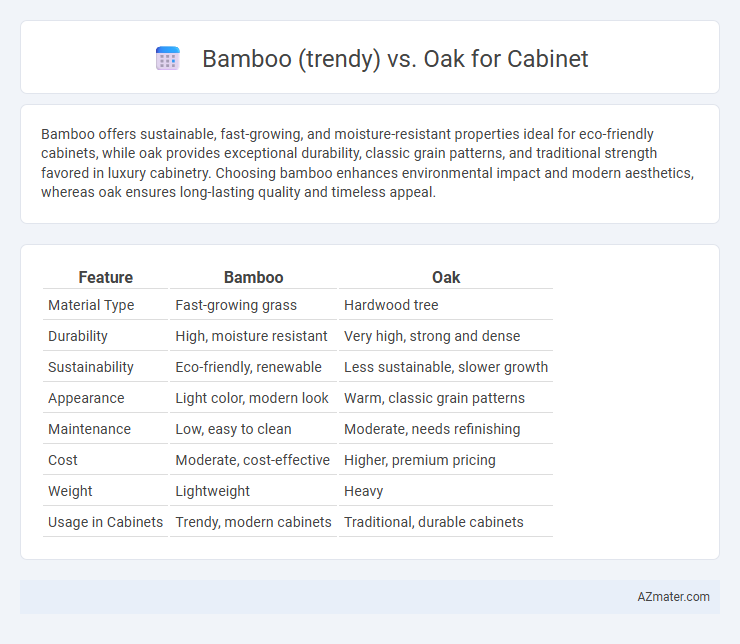Bamboo offers sustainable, fast-growing, and moisture-resistant properties ideal for eco-friendly cabinets, while oak provides exceptional durability, classic grain patterns, and traditional strength favored in luxury cabinetry. Choosing bamboo enhances environmental impact and modern aesthetics, whereas oak ensures long-lasting quality and timeless appeal.
Table of Comparison
| Feature | Bamboo | Oak |
|---|---|---|
| Material Type | Fast-growing grass | Hardwood tree |
| Durability | High, moisture resistant | Very high, strong and dense |
| Sustainability | Eco-friendly, renewable | Less sustainable, slower growth |
| Appearance | Light color, modern look | Warm, classic grain patterns |
| Maintenance | Low, easy to clean | Moderate, needs refinishing |
| Cost | Moderate, cost-effective | Higher, premium pricing |
| Weight | Lightweight | Heavy |
| Usage in Cabinets | Trendy, modern cabinets | Traditional, durable cabinets |
Bamboo vs Oak Cabinets: An Overview
Bamboo cabinets offer exceptional sustainability and faster renewability compared to traditional oak, making them an eco-friendly choice for modern kitchens. Bamboo's natural hardness and resistance to moisture provide durability similar to oak, while its unique grain patterns add a contemporary aesthetic appeal. Oak cabinets, known for their classic strength and rich texture, tend to be heavier and more expensive, but they offer timeless elegance and long-term reliability.
Material Characteristics: Bamboo and Oak
Bamboo offers a highly renewable and eco-friendly material choice for cabinets, known for its rapid growth and durability, with natural resistance to moisture and insects. Oak provides classic strength and solid hardwood density, featuring prominent grain patterns and excellent resistance to warping and wear over time. Bamboo's lighter weight and flexibility contrast with oak's heavier, more rigid structure, making bamboo ideal for modern, sustainable designs while oak suits traditional, high-end cabinetry.
Sustainability and Environmental Impact
Bamboo cabinets offer superior sustainability due to their rapid growth rate, maturing in 3-5 years compared to oak's 20-30 years, which reduces deforestation pressure and enhances carbon sequestration. Oak, a hardwood, has a slower regeneration rate and higher environmental impact from harvesting, though it provides long-lasting durability and recyclability. Bamboo's minimal pesticide use and ability to thrive in diverse climates support eco-friendly production, making it a preferred choice for environmentally conscious cabinetry.
Durability and Lifespan Comparison
Bamboo cabinets offer excellent durability due to their tensile strength and resistance to moisture, making them less prone to warping and cracking compared to traditional wood. Oak, known for its robust hardness and dense grain, provides a long lifespan often exceeding several decades when properly maintained. While oak tends to resist dents and scratches better, bamboo's rapid renewability and natural resilience make it a sustainable yet durable choice for cabinetry.
Aesthetic Appeal and Design Versatility
Bamboo cabinetry offers a sleek, modern aesthetic with its smooth, light grain and uniform texture, making it ideal for contemporary designs. Oak provides a classic, warm appearance with rich, pronounced grain patterns that enhance traditional and rustic interiors. Both materials deliver design versatility, but bamboo's rapid renewability and ability to be engineered into various finishes make it a sustainable choice with adaptable style options.
Maintenance and Care Requirements
Bamboo cabinets require minimal maintenance due to their natural resistance to moisture and insects, making them ideal for humid environments. Oak cabinets demand more care, including regular sealing and polishing, to prevent scratches and water damage due to their porous grain structure. Both materials benefit from gentle cleaning with mild soap and avoiding excessive water exposure to maintain longevity.
Cost Comparison: Bamboo vs Oak Cabinets
Bamboo cabinets typically cost between $15 and $30 per square foot, offering a more budget-friendly option compared to oak cabinets, which range from $30 to $60 per square foot. Bamboo's rapid growth and renewable properties contribute to its lower price while providing durability similar to oak. Choosing bamboo can significantly reduce cabinet expenses without sacrificing quality or aesthetic appeal.
Installation Process and Challenges
Bamboo cabinets are relatively lightweight and feature tongue-and-groove joints, making their installation faster but requiring precise alignment to avoid gaps due to bamboo's natural expansion. Oak cabinets, known for their heavier and denser wood, demand sturdy mounting hardware and careful handling to prevent damage during installation, especially considering oak's tendency to swell in humid environments. Both materials require acclimation to indoor humidity levels before installation to minimize warping and ensure long-term durability.
Popular Trends: Why Choose Bamboo or Oak?
Bamboo cabinets are rapidly gaining popularity due to their eco-friendly nature, rapid renewability, and modern aesthetic appeal that fits well with minimalist and sustainable interior designs. Oak remains a timeless choice favored for its durability, rich grain patterns, and ability to complement traditional and rustic kitchen styles. Choosing between bamboo and oak depends on prioritizing sustainability and contemporary trends versus classic strength and long-lasting elegance.
Making the Right Choice: Bamboo or Oak for Your Cabinets
Bamboo cabinets offer sustainability and rapid renewability, with durability comparable to oak, making them an eco-friendly choice for modern kitchens. Oak, valued for its classic grain patterns and hardness, ensures long-lasting performance and a traditional aesthetic appeal. Selecting between bamboo and oak depends on prioritizing environmental impact versus timeless durability and style in cabinet design.

Infographic: Bamboo (trend) vs Oak for Cabinet
 azmater.com
azmater.com